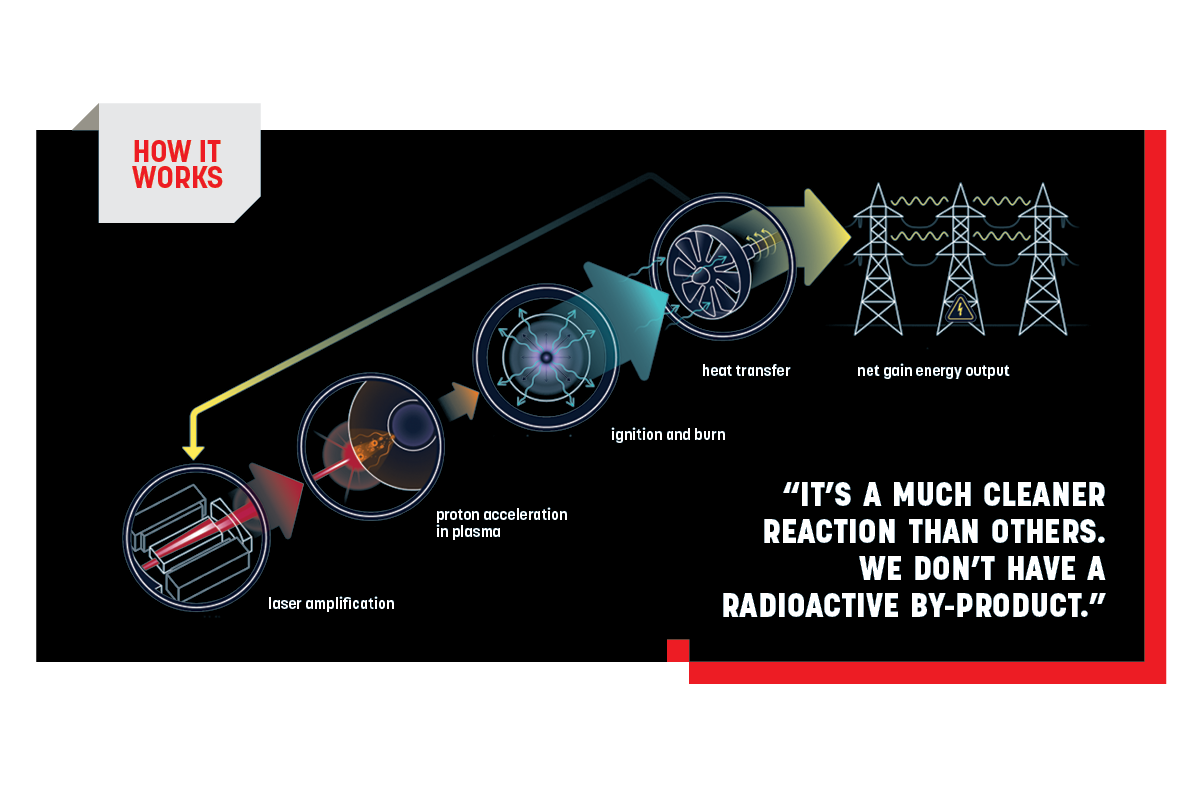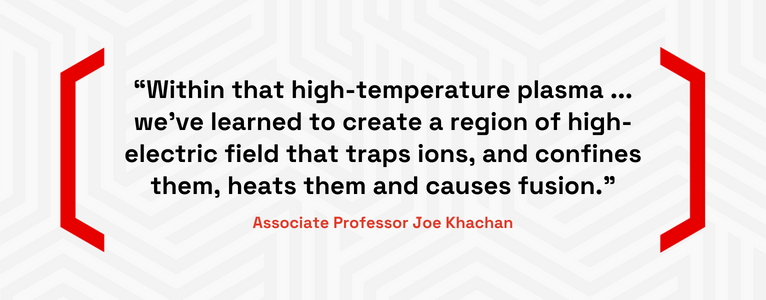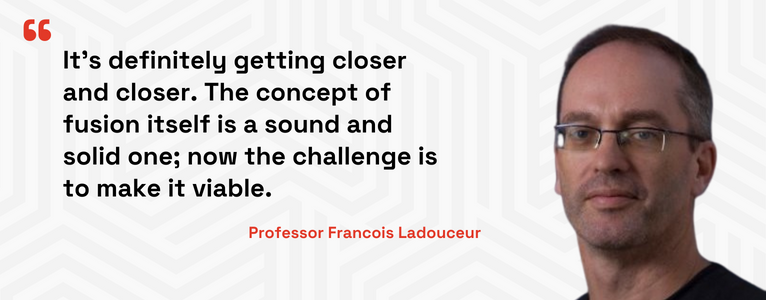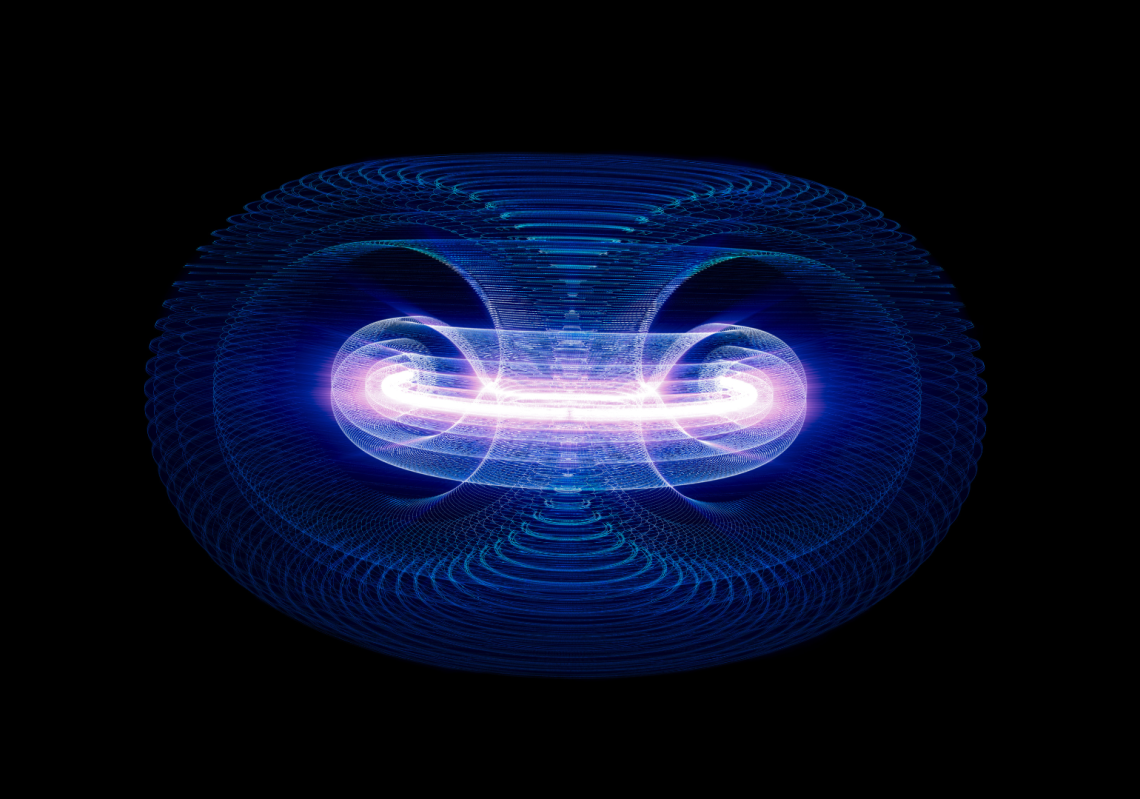Derided as eternally “25 years into the future”, fusion energy is proving increasingly viable, and an Australian business is among the companies racing for the prize.
Just after one a.m. on Monday 5 December 2022, in a low-slung laboratory in a suburb on the far eastern edge of the San Francisco Bay Area, a laser shot 2.05 MJ of energy at a tiny capsule of cryogenically frozen hydrogen.
The burst was so intense that it overcame the electrostatic force separating the nuclei of these heavy isotopes of hydrogen – deuterium and tritium – from one another. What once was hydrogen became helium. This transformation released a vast amount of energy: 3.15 MJ, more than 50 per cent greater than the laser energy required to kick off the process.
This same transformation, fusion, is the one that powers the stars, including the Earth’s sun. But the team at the US’s National Ignition Facility, a part of the Lawrence Livermore National Laboratory, had achieved fusion under controlled conditions, achieving for the first time what is known as “scientific energy breakeven”: they produced more energy from the reaction than it took to set it off.
Over the next 12 months, the National Ignition Facility repeated the feat three more times, obtaining in one instance as much as 3.88 MJ of energy from a 2.05 MJ laser pulse.
What was once the realm of conjecture and imagination – the production of energy from controlled fusion – had been empirically shown to be possible, and interest in the potential has extended far beyond government researchers.
Around the world, a number of private companies are trying to make fusion energy a feasible and profitable source of power – including one founded in the eastern suburbs of Sydney.
Future potential
Sitting down with Warren McKenzie, CEO and co-founder of Australian fusion business HB11 Energy, create wanted to know if fusion power had left the realm of fiction and become a technology with a very real future.
“Yes,” McKenzie, a materials engineer, replied assuredly. “‘Yes’ is the very, very short answer to that.”
McKenzie’s demeanour reflects that confidence; he is relentlessly optimistic about the potential of fusion power. But the journey to commercial viability will not be an easy one.
The National Ignition Facility’s energy gain of 1.5 times its input was a remarkable scientific achievement, but a plant that provides power even at today’s prices would require the process to deliver 100 times more energy than it takes in. Reach a net energy gain of 1000, and prices would come down to a tenth of their current level.

“The two main fusion approaches have passed the point of being a question over whether the science is viable,” McKenzie said. “The question now is: can they become economically viable? And that begins to be a lot more of an engineering than a science question.”
One of the approaches McKenzie mentions is that used by the National Ignition Facility, which uses deuterium and tritium for fuel. HB11, however, seeks to fuse atoms of hydrogen and boron.
That approach is not an entirely intuitive one, McKenzie admitted.
“It was a crazy idea for a very long time,” he said. “The temperatures that you need for hydrogen-boron fusion are an order of magnitude higher than you need for hydrogen-hydrogen fusion.”
But hydrogen-hydrogen fusion is not without complications either: tritium is a super-heavy form of hydrogen that doesn’t exist naturally on Earth. It is not stable and needs to be produced artificially, adding to the engineering complexity of any process that uses it.
Boron, however, is plentiful, stable and does no harm to the human body.
Boron benefits
“The upside of our approach is twofold,” said Professor Francois Ladouceur, an electrical engineer on the HB11 research team. “First is the fact that when you fuse hydrogen and boron, it turns into an unstable nucleus and self-splits into three identical parts, which are helium nuclei.”
These nuclei, which are also known as alpha particles, are highly energetic, but they are not radioactive.
“It’s a much cleaner reaction than others,” Ladouceur said. “We don’t have an intrinsic radioactive by-product.”

But the super-fast helium nuclei produced by hydrogen-boron fusion have another advantage, he explained.
“We can harness this energy very easily, because the nuclei are electrically charged and we can use those moving charges as a current,” Ladouceur said. “We can drive a turbine, for example, with that current, so potentially the reactor itself is much simpler.”
The hydrogen-hydrogen approach, by contrast, requires harnessing the heat generated by the fusion reaction to boil water, and then using the resulting steam to drive a turbine and generate electricity.
Associate Professor Joe Khachan, a member of the University of Sydney’s Fusion Group, describes hydrogen-boron fusion as “the holy grail”.
“You don’t have to worry about thermal cycles,” he told create. “It’s very high efficiency – just fusion to electricity.”
Overcoming cynicism
Khachan acknowledges that public cynicism has developed around fusion energy, but he remains confident in the technology’s potential.
“We’re looking at maybe just over 10 years to try and demonstrate a fusion energy reactor that operates continuously, like a power station,” he predicted. “At that point, then there’s engineering issues. Once you demonstrate it, then … there’s electrical engineering, materials engineering, all sorts of engineering that needs to be done.”
Khachan is pursuing his own approach to fusion, though he acknowledges that he is working at a smaller scale than HB11. What distinguishes his technique, however, is not the fuel powering the fusion reaction, but how the process begins in the first place.

As part of the Fusion Group, Khachan is exploring fusion that can take place on a much smaller scale, and which uses inertial electrostatic confinement to contain the reaction. This contrasts with the donut-shaped tokamak devices that use a powerful magnetic field to contain plasma.
“Our aim at the University of Sydney is to use an electric field to create fusion,” Khachan explained. “We’ve built a machine – it’s not high powered at all – but it’s enough to demonstrate that we can create a plasma which has a localised region of attractive electric fields, sometimes called a potential well.”
Using this plasma to contain the fuel means that there is no metal for the ions to collide with, as would take place if the process used high-voltage electrostatic electrodes, leading to immense energy loss.
Khachan’s approach is a departure, but he said the science behind it is solid.
“It uses mainstream plasma physics; it doesn’t require trapping of particles like electrons in any way,” he said. “Within that high-temperature plasma – which is what the traditional fusion-plasma research is about – we’ve learned to create a region of high-electric field that traps ions, and confines them, heats them and causes fusion.”
His other problem is funding; he runs a shoestring operation and dreams of attracting investment to match his aspirations.
At the other end of the scale, however, is US company Helion, which has raised US$677 million since its 2013 founding.
OpenAI CEO Sam Altman is a major investor and, last year, Helion agreed to provide Microsoft with energy from a plant that would come online in 2028 and produce 50 MW or greater after a one-year ramp-up period.
The target is ambitious and includes financial penalties if Helion is unsuccessful. Nevertheless, it has attracted some sceptical responses.
“I would say it’s the most audacious thing I’ve ever heard,” University of Chicago theoretical physicist Robert Rosner told The Verge.
“In these kinds of issues, I will never say never. But it would be astonishing if they succeed.”
Helion combines the National Ignition Facility’s hydrogen fuel and inertial containment approach with the magnetic confinement produced by a tokamak.
“We use an approach that takes different aspects of these two approaches and combines them into an approach called magneto-inertial fusion (MIF),” Helion explained on its website.
“Our MIF concept uses magnets to create and confine plasma, then compresses the plasma to fusion conditions. Due to how efficient our system is, we do this without needing to reach ignition.”
Helion CEO David Kirtley said his goal is to get the technology out to humanity as soon as possible.
“We’re building a full-scale fusion system and doing this in a way that makes commercial sense,” he said in a video produced by the company. “Fusion is hard and we have a lot of work to do to get from where we are to powering your home.”
In it together
Despite the range of competing approaches, many of the players in fusion approach the challenge in a spirit of friendly competition.
“Our goal is to get the hydrogen-boron concept we’re working on to be the one that’s built,” McKenzie said. “But even if the [successful] concept is slightly different to that, we’ll probably have some laser technology or some fuel technology or some other technology which could be brought into that.”
The winning technology will depend on which one can offset its strengths and weaknesses best.
“If DT fusion gets to gains of 10,000 or 100,000, while hydrogen-boron fusion has gone nowhere, the costs of using tritium will probably be outweighed by the ability to generate energy,” McKenzie said.
“Meanwhile, if boron gets anywhere close to where deuterium-tritium is, absolutely boron will win the race, because we’re a lot safer.”

Ladouceur said he is excited about HB11’s potential.
“It’s a multiyear effort that will require tens of millions of dollars to bring to success,” he said. “But if it is the winning technology that will lead to commercially viable fusion, then for Australia, it’s going to be a fantastic outcome.”
And even though Khachan has taken a different route to achieving viable fusion, he believes international collaboration will be necessary to solve many of the technical challenges.
“There has to be collaboration in the end by any of these fusion companies, because nobody is equipped to do all that sort of engineering by themselves. In the end, you need the engineering to get the power out,” he said.
“You need to find out ways of extracting the energy, which means you need materials research … There’s going to be megawatts of power that ordinarily would melt and destroy the materials.”
Bright future
As Ladouceur puts it, for fusion energy’s doubters, the technology is one that is eternally just around the corner: “constantly 25 years in the future”. And even the optimists create spoke to did not discuss timelines as abbreviated as those on which companies such as Helion are operating.
“It’s certainly very challenging,” said Ladouceur. “But it’s definitely getting closer and closer. The concept of fusion itself is a sound and solid one; now the challenge is to make it viable.”
Optimistically, he foresees a future in which humanity receives continuous baseload power from small and cheap yet powerful reactors that run on Earth’s vast supplies of hydrogen and boron.
“It means that there would never be any shortage of energy in the future,” Ladouceur said.
Khachan expects to see proof-of-concept reactors emerging in the next 10 to 15 years, and while McKenzie believes that it is overselling the technology to say it can be operational in 10 years, he said an industry roadmap produced by the US’s National Academies of Sciences, Engineering and Medicine foresees a pilot plant could be built between 2035 and 2040.
“That would be enough time to have widely distributed fusion in the energy mix by 2050,” he said. “With some breakthroughs, it could happen much faster; with some setbacks, it could be a lot longer.”



